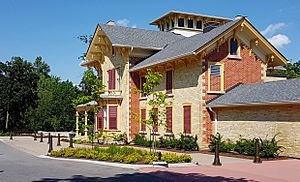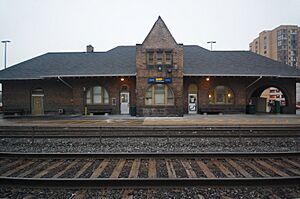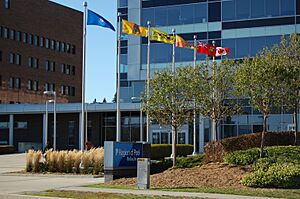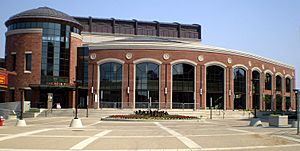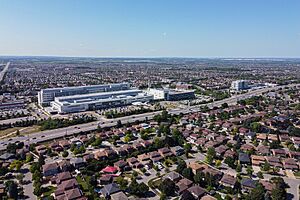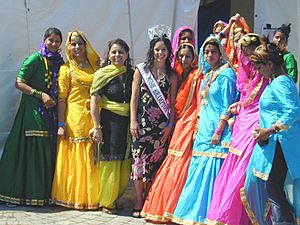History of Brampton facts for kids

This is the story of Brampton, a big city in Ontario, Canada. It's the fourth largest city in the province! European settlers started living here in the early 1800s. Brampton officially became a village in 1853.
Contents
Early Days: Before the 1900s
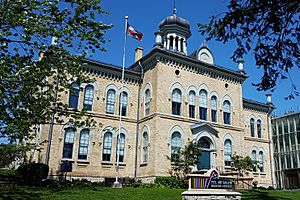
Long ago, the Mississaugas of the Credit First Nation lived on a huge amount of land. This land included the area where Brampton is today. In 1818, a land agreement called the Ajetance Purchase was made. It was between the Mississaugas of the Credit and the United Kingdom.
Before 1834, there wasn't much here except William Buffy's tavern. People even called the area "Buffy's Corners." Most of the local business happened at Martin Salisbury's tavern, about a mile away. In 1834, a man named John Elliott started selling land lots. He gave the area the name "Brampton," and it quickly stuck!
In 1853, a small agricultural fair began in Brampton. Farmers sold grains, fresh produce, and dairy products. They also sold horses, cattle, and other farm animals. This fair was the start of today's Brampton Farmers' Market. In the same year, Brampton officially became a village. A few years later, in 1856, the Grand Trunk Railway built a train station and railway line in Brampton.
In 1867, Peel County became separate from York County. They had been joined since 1851. In 1884, a group of mechanics formed the Brampton Concert Band. It's one of Canada's oldest community bands! By 1869, Brampton had about 1,800 people living there.
Growing Up: The 1900s
In 1902, Sir William James Gage bought part of a large estate called Alder Lea. He was a publisher of school textbooks. Sir William donated some of this land to the town. He wanted it to be a park for everyone to enjoy. Citizens also donated money to buy even more land for the park.
By 1922, Brampton's population had grown to 8,000 people. The Capitol Theatre was built downtown. It showed silent movies and vaudeville acts. Farmers in Brampton had trouble getting insurance from city companies. So, they started their own company, the County of Peel Farmers Mutual Fire Insurance Company. This company, now called Peel Mutual Insurance Company, is the longest-running business in modern Brampton.
Harmsworth Decorating Centre started in 1890. It's the longest-operating retail business in Brampton. The Brampton Mall opened in 1960. It was the community's first shopping mall.
The 1970s: New Developments
Bramalea: A New Kind of Town
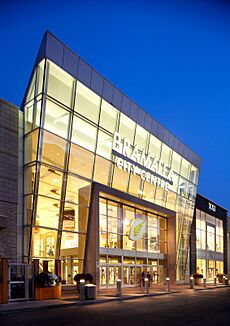
Bramalea was a special "new town" built about 40 kilometers northwest of Toronto. It was Canada's first planned community built by a big real estate company. The name "Bramalea" was created by a farmer named William Sheard. He combined "Bram" from Brampton, "Mal" from Malton, and "ea" from his farm, SunnymEAd Farms.
Bramalea had a detailed plan. It included a system of park trails and a "downtown" area. This downtown had important services and a shopping centre. The main building was the Civic Centre, with the city hall and library. Right across from it was the Bramalea City Centre mall. The community also had a police station, fire hall, and bus terminal.
Each part of the new city had street names starting with the same letter. The first section had "A" streets like Argyle. Then came "B" streets, "C" streets, and so on. Kids from different sections would even play street hockey games against each other! Bramalea also had many places for fun, like tennis courts, playgrounds, and swimming pools.
Air Canada Flight 621 Crash
On July 5, 1970, Air Canada Flight 621 crashed in Brampton. All 109 people on board died. It was a very sad event. The plane was flying from Montreal to Los Angeles, with a stop in Toronto.
A special place called "Purple Lilac Memorial Park" was opened on July 4, 2013. It remembers those who died. Lilac trees bloom there, and 109 pink granite markers are set along a path. Each marker stands for one person who was lost.
Changes in Government
In 1974, the government changed how Peel County was organized. Several towns and villages joined together to form the new City of Mississauga. The current City of Brampton was also created. It included the old town of Brampton and parts of Chinguacousy and Toronto Gore. This included areas like Bramalea and Churchville.
Peel County became the Peel Region. Brampton remained the main administrative center. The regional council, the Peel Regional Police, and the main museum are all in Brampton.
In 1972, a new civic center for Chinguacousy Township opened in Bramalea. When Brampton and Chinguacousy merged two years later, this building became the new city hall. The libraries of Brampton and Chinguacousy also joined together.
Some people have wondered about the future of Peel Region. Mississauga's mayor, Hazel McCallion, wanted Mississauga to be a separate city. She felt that Mississauga was big enough to manage itself. She also thought Mississauga was paying too much to support Brampton and Caledon.
Late 1900s: Culture and Growth
In the 1980s, the Capitol Theatre closed. The City bought it in 1981. It was turned into a theatre for music and performing arts. It was renamed the Heritage Theatre.
Carabram started in 1982. Volunteers from different communities wanted to celebrate diversity. The first Carabram event had Italian, Scottish, Ukrainian, and West Indian groups. By 2003, 45,000 people visited 18 different cultural pavilions.
In the early 1990s, a new city hall was built in downtown Brampton. The Brampton Fair Grounds were sold to the City in 1992. The Agricultural Society moved to a new location in 1997.
In 1997, three hospitals joined together to form the William Osler Health Centre. These were Georgetown and District Memorial Hospital, Etobicoke General Hospital, and Peel Memorial Hospital. In 2006, the Brampton hospital was renamed back to Peel Memorial Hospital.
Brampton in the 2000s
In 2002, the City Council started the "Flower City Strategy." This plan was to celebrate Brampton's history of growing flowers. It aimed to make the city more beautiful with landscaping. It also wanted to protect nature and culture. The Rose Theatre was named to fit this idea. It opened in 2006 as a place for arts and culture. Brampton also takes part in the national Communities in Bloom competition.
The Rose Theatre was meant to bring new businesses to local restaurants and shops. The city hoped it would create many jobs and attract visitors. However, some people in the community wondered if such a large theatre was really needed.
A new hospital was built in north Brampton. The Brampton Civic Hospital opened in 2007. It took the place of the older Peel Memorial Hospital.
Brampton celebrated its 150th birthday in 2003. This boosted community spirit! A summer parade with 100 floats was restarted. The city also brought back more flower plantings.
Brampton also supports its Lesbian, Gay, Bisexual, and Transgender community. Mayor Susan Fennell declared Gay Pride Day in 2004 and 2005. A Gay Pride Week was held in 2006.
The city's mascot is "Sassy the Sesqui Squirrel."
Embracing Diversity
Brampton has a growing population with many different cultures. The Peel Board of Education started offering evening English as a Second Language (ESL) classes. These classes help people learn English. Later, they became daytime courses taught by paid teachers.
In the 1980s, schools expanded their language programs. They offered night classes in 23 different languages. Parents wanted their children to learn about their family's heritage and language.
See also


